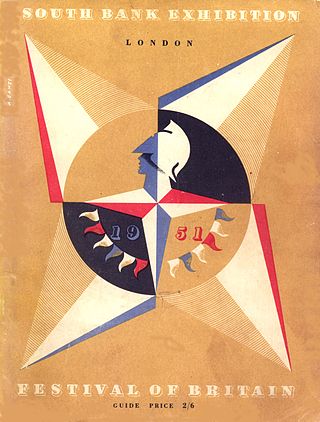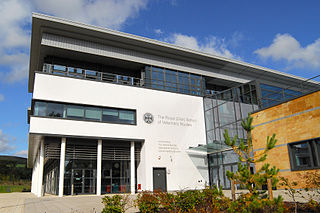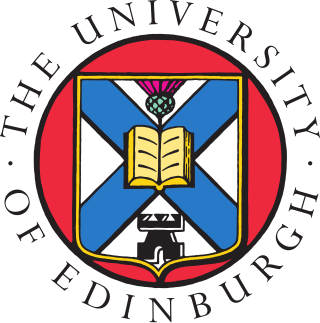Related Research Articles

The Festival of Britain was a national exhibition and fair that reached millions of visitors throughout the United Kingdom in the summer of 1951.

The Hunterian is a complex of museums located in and operated by the University of Glasgow in Glasgow, Scotland. It is the oldest museum in Scotland. It covers the Hunterian Museum, the Hunterian Art Gallery, the Mackintosh House, the Zoology Museum and the Anatomy Museum, which are all located in various buildings on the main campus of the university in the west end of Glasgow.

The School of Informatics is an academic unit of the University of Edinburgh, in Scotland, responsible for research, teaching, outreach and commercialisation in informatics. It was created in 1998 from the former department of artificial intelligence, the Centre for Cognitive Science and the department of computer science, along with the Artificial Intelligence Applications Institute (AIAI) and the Human Communication Research Centre.

Jon Reid Oberlander FRSE was a British philosopher and cognitive scientist who was Professor of Epistemics at the School of Informatics, University of Edinburgh. He received a BA in Philosophy from Pembroke College, Cambridge, in 1983 and a PhD in Cognitive Science from the University of Edinburgh in 1987.

The Forest, also referred to as Forest Café, was an independent social centre and arts centre located in central Edinburgh, Scotland. It was notable for being run by volunteers as a charitable, self-sustaining not-for-profit. The Forest was initially housed at a West Port venue from 2000 to 2003, then housed at 3 Bristo Place in the former Edinburgh Seventh Day Adventist Church, a building owned by the Edinburgh University Settlement until August 2011. It featured a two room café with performance space, a single room art gallery named Total Kunst, a radical library named Old Hat Books housed in the café front room, an Action Room for consensus process based organisational working group meetings and internet access, artist gallery spaces, a meeting cum screen printing and crafting room, a rehearsal/music studio, a walk-in freezer, a woodworking and machining room, a darkroom specialising in alternative photographic process, and unisex toilets. In August 2012 The Forest reopened at 141 Lauriston Place, Tollcross where it continued its activity as a volunteer-run vegetarian cafe with regular free events and workshops, assuming a pivotal role in the revival of the independent community development in central Edinburgh. In 2022 the physical space closed citing difficulties arising from the COVID-19 pandemic, despite arts activities continuing decentrally.

Indira Gandhi National Centre for the Arts (IGNCA), New Delhi is a premier government-funded arts organization in India. It is an autonomous institute under the Union Ministry of Culture.

Appleton Tower is a tower block in Edinburgh, Scotland, owned by the University of Edinburgh.

Edinburgh Science, founded in 1989, is an educational charity. It organises a two-week Edinburgh's annual Science Festival, the world's first public celebration of science and technology, and still one of Europe's largest. Alongside the annual Festival in Edinburgh, the organisation has a strong focus on education and runs touring programme Generation Science that visits schools around Scotland throughout the year. Edinburgh Science also operates a large-scale international programme of work under the Worldwide arm. It regularly presents events overseas and has been the major programming partner of the annual Abu Dhabi Science Festival, helping to curate, produce, and deliver the event.

The MIT Museum, founded in 1971, is located at the Massachusetts Institute of Technology in Cambridge, Massachusetts. It hosts collections of holography, technology-related artworks, artificial intelligence, architecture, robotics, maritime history, and the history of MIT. Its holography collection of 1800 pieces is the largest in the world, though only a few selections from it are usually exhibited. As of 2023, works by the kinetic artist Arthur Ganson are the largest long-running displays. There is a regular program of temporary special exhibitions, often on the intersections of art and technology.

The Royal (Dick) School of Veterinary Studies, commonly referred to as the Dick Vet, is the University of Edinburgh's vet school. It is part of the College of Medicine and Veterinary Medicine.

The Assembly Hall is located between Castlehill and Mound Place in Edinburgh, Scotland. It is the meeting place of the General Assembly of the Church of Scotland.

Dynamic Earth is a not-for-profit visitor attraction and science centre in Edinburgh, and is Scotland's largest interactive visitor attraction. It is located in Holyrood, beside the Scottish Parliament building and at the foot of Salisbury Crags. It is a registered charity under Scottish law and is owned as The Dynamic Earth Charitable Trust. The centre was opened by Queen Elizabeth II in 1999.

The Informatics Forum is a major building on the Central Area campus of the University of Edinburgh. Completed in 2008, it houses the research institutes of the university's School of Informatics.
The Six Cities Design Festival is an international design festival that takes place simultaneously in Scotland's six cities: Aberdeen, Dundee, Edinburgh, Glasgow, Inverness, and Stirling. 2007 is the Festival's inaugural year; a main festival period of over 300 public exhibitions and events ran from 17 May — 3 June. Two ongoing Six Cities Design Festival initiatives, Design into Business and Learning, continue to offer conferences, workshops and classes nationwide. The Six Cities Design Festival is delivered by The Lighthouse (Glasgow): Scotland's National Architecture and Design Centre. The 2007 festival was backed by £3 million from The Scottish Government.

The National Museum of Scotland in Edinburgh, Scotland is a museum of Scottish history and culture.

Bristo Square, Edinburgh, Scotland, is a public space on the estate of the University of Edinburgh. It lies in the south of the city, between George IV Bridge and George Square.

The University of Edinburgh is a public research university based in Edinburgh, Scotland. Founded by the town council under the authority of a royal charter from King James VI in 1582 and officially opened in 1583, it is one of Scotland's four ancient universities and the sixth-oldest university in continuous operation in the English-speaking world. The university played a crucial role in Edinburgh becoming a leading intellectual centre during the Scottish Enlightenment and contributed to the city being nicknamed the "Athens of the North".

Arts Catalyst is a visual arts organisation and charity based in Sheffield, UK. They commission artists and use art to explore social and environmental issues, provoke debate, and test out alternative ways of learning, frequently working in non-traditional arts spaces, often within a particular landscape.

The Edinburgh Cancer Research Centre (ECRC), also known as the University of Edinburgh Cancer Research Centre, is a center for basic, translational and clinical cancer research located in Edinburgh, Scotland. ECRC constitutes a part of the Institute of Genetics & Molecular Medicine (IGMM) and is positioned in direct proximity of the Western General Hospital, where most of its clinical activities take place.

Summerhall is an arts complex and events venue in Edinburgh, Scotland. Formerly home to the Royal (Dick) School of Veterinary Studies of the University of Edinburgh, it is now a major Edinburgh Festival Fringe visual and performing arts venue. It also hosts events for the Edinburgh Science Festival and Edinburgh International Magic Festival and provides a home for arts practitioners year round; its many rooms are used for art exhibitions, drama and music performances, libraries, small museums, educational & research programmes, artist studios, arts organisation offices, and workshops.
References
- ↑ "Inspace – art | design | technology | research" . Retrieved 2022-04-25.
- ↑ "Home". Design Informatics. Retrieved 2022-04-25.
- ↑ "Festival - Edinburgh Science". Edinburgh Science. Retrieved 2022-04-25.
- ↑ "InSpace : Education : Scotland's New Buildings : Architecture in profile the building environment in Scotland". Urban Realm. Retrieved 2022-04-25.
- ↑ "New Media Scotland". www.mediascot.org. Retrieved 2022-04-25.
- ↑ "Obituary: Jon Reid Oberlander, academic, Professor of Epistemics, co-founder and first director of the Scottish Informatics and Computer Science Alliance". www.scotsman.com. Retrieved 2022-04-25.